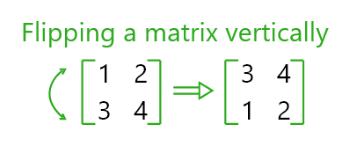Vertical Flip Matrix Problem in JavaThe problem statement for vertical flipping of a matrix involves taking a two-dimensional matrix and reversing the order of its rows, essentially flipping it vertically. Mathematically, if the original matrix is denoted as M and the vertically flipped matrix as M', the transformation can be represented as follows:
In simple words, vertical flip of a matrix can be performed by reversing the order of its rows. The operation is useful in various image processing and computer graphics applications, as well as in certain algorithms and data manipulation tasks. 
Method 1: Using a Temporary MatrixOne way to vertically flip a matrix is by creating a new matrix and copying the rows in reverse order. Let's implement the approach in a Java program. MatrixVerticalFlip.java Output: Original Matrix: 1 2 3 4 5 6 7 8 9 Vertically Flipped Matrix: 7 8 9 4 5 6 1 2 3 Explanation Given an input matrix, loop through the original matrix to copy elements in reverse order to the new matrix (flippedMatrix). A useful function to print a matrix's elements is the printMatrix() method. The verticalFlip() method is invoked to retrieve the flipped matrix in the main function that provides an example matrix. Next, the flipped and original matrices are printed. Time Complexity The time complexity for creating the new matrix and replicating the elements is O(rows * cols), where "rows" denotes the number of rows and "cols" is the number of columns. It is necessary to traverse the original matrix O(rows * Cols) times. The entire time complexity is O(rows * Cols). Space Complexity The additional matrix made to store the flipped items determines the space complexity. Due to the allocation of a new matrix of the same size, the space complexity is O(rows * cols). Method 2: Using In-Place Vertical FlipThis technique flips the vertically in place without requiring a separate matrix: InPlaceVerticalFlip.java Output: Original Matrix: 11 22 33 44 55 66 77 88 99 In-Place Vertically Flipped Matrix: 77 88 99 44 55 66 11 22 33 Explanation By switching elements along the vertical axis, the inPlaceVerticalFlip() function executes a vertical flip in place given an input matrix. The elements of a matrix are printed once again using the printMatrix() technique. The inPlaceVerticalFlip() method is called the main method, which also provides an example matrix. Next, the flipped and original matrices are printed. Time Complexity O(rows/2 * cols) is the time required to iterate through half of the rows. The entire time complexity O(rows * Cols). Space Complexity With the exception of a few variables, the in-place technique uses no additional space proportionate to the size of the matrix. O(1) space complexity denotes constant space.
Next TopicCalling Object in Java
|
 For Videos Join Our Youtube Channel: Join Now
For Videos Join Our Youtube Channel: Join Now
Feedback
- Send your Feedback to [email protected]
Help Others, Please Share









